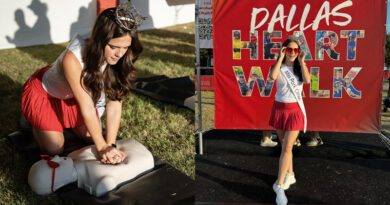HP Town Council Addresses Flood Plan, Wycliffe Bridge
With all twelve rows filled six seats deep, the last minute addition of chairs wasn’t enough to accommodate the growing crowd of Highland Park residents in attendance at the Dec. 17 special Town Council meeting.
Mayor Will C. Beecherl opened the 3 p.m. meeting acknowledging the Council’s recognition of the residents’ concerns about plans to restructure the dam and roadway along Wycliff Avenue, assuring attendees ample time for Q&A following the presentation.
Before playing a video from May 18, 2019, in which Highland Park police officers respond to a vehicle being swept away by floodwaters, the mayor asked if the town’s residents were willing to assume the loss of life with the status quo.
With flood waters rising several feet in near-instantaneous rapidness and tree trunks disappearing underwater, a submerged car vanishes from frame.
A team of civil engineers followed with detail of the existing challenges which include a history of six overtopping events on Wycliff Avenue since 2022, 34 triggering events of the barricading components, the dam’s classification by the Texas Commission on Environmental Quality (TCEQ) as a high-hazard structure among three categories of low, significant, and high; the experts summed up the risks by pointing out the fundamental danger to public safety.
The technical goals for the modifications were explained with plans to reduce the dam classification from high to low, to pass the 100-year storm event without overtopping Wycliff Avenue, to remove structures and reduce limits of flood plain, to maintain existing water levels in Connor Lake, to conform with nationwide environmental regulation permits, and to ultimately increase public safety.

The team laid out their proposed solutions for meeting the technical goals, which include a 2.5-foot roadway elevation, construction of a weir and bridge, removal of standpipe, and widening and maintaining the downstream channel flow lines.
Project considerations included plans for structural aesthetics of landscaping and pedestrian areas. Roadway geometry diagrammed the rerouting of regional and neighborhood traffic, with residents of the immediate area maintaining access to their homes at all times.

The presentation concluded with an overview of the project’s organization and clean up plans, a sequence of work, construction time limits, an assurance for communication and coordination with residents, and a projected total price tag of $21,830,000, primarily covered by outside funding, with a $6,132,000 cost to the Town.
As the mayor opened audience dialogue, a query was posed: “If we don’t want this to happen, how do we stop it? …I think it’s a horrible idea, so I’d like to know how we kill this?”
“I don’t think they put any thought into how ugly that concrete is and all the graffiti that’s gonna be on the concrete — the kids with skateboards, the homeless people … and I don’t want that across the street from my house,” said the concerned citizen, adding “I like what we have now … we like it the way it is.”
Residents aggravated that they had not been apprised of the plan voiced concern for its rapid progression without residents’ input, one homeowner recalling an exhaustive procedure after he installed artificial grass, inquiring why the Town’s strict guidelines for aesthetic cohesiveness were being removed from the project.
Mayor Beecherl responded with reference to stipulations in an ongoing lawsuit that are attached to the project as part of a pending settlement.

With an overriding message that halting the project was not a viable consideration, several attendees pivoted to addressing the possibility of postponing the start date, slated for some time next summer, and raised concern for the lack of alternative renderings of the outdoor spaces, suggesting a refocus on preserving the natural landscape of the neighborhood.
The proposed reduction of the already-congested lanes of Wycliff, Avondale, and Fitzhugh caused unease with HP resident John Roach, who acknowledged the rapid rise of flash floods in the area, but warned that the closing of Fitzhugh “would not just mildly inconvenience residents, but will be a disaster.”
The two-hour discussion was tabled until the next forum, with community members urged to add their information to the contact list upon exiting.









